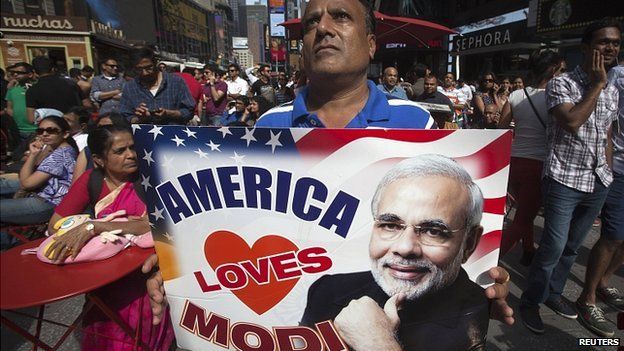The Desi in America And the Seductive Appeal Of A Hindu Rashtra

SINGAPORE: Since the racially/religiously-targeted attack on Srinivas Kuchibhotla and Alok Madasani -- Srinivas later succumbed to the injury and Madasani was released from hospital -- social media posts from desis, the Indian diaspora primarily in the U.S., have erupted with anxieties about what appears to be a resurgence of racism in the U.S. in the backdrop of U.S. President Donald Trump’s election.
It is as if these desis have woken up publicly to the hatred they find around themselves in the post-Trump U.S.
The anxiety generated by the attack is compounded by anxieties about the status of H1B visas. Some of these anxieties are assuaged by the fervently held belief in the muscular power of the Indian Prime Minister, Mr. Narendra Modi, to work miracles. Then there is also the hope that Mr. Donald Trump would hold to his professed love for “The Hindu.”
The desi ideology, emboldened in its “model minority” status in the US, has strong faith in the Aryan nation imaginary, finding solace in the promise of the American dream. The desi sees himself as a natural appendage to the U.S., earning his well-justified wealth through his gifted intellect and the ethic of hard work. He considers himself as distinct from the “Mexican wetbacks that come to the U.S. illegally.”
He reasons, “Indians run Silicon Valley, and make up most of the doctors and engineers in the US.” The desi sees himself as above the everyday American. Moreover, as a natural extension of the US, he regales in his presumed be/longing.
In his racist worldview, African Americans are “kallus” (derogatory reference anchored in skin color), stereotypically constructed as prone to drugs, violence, and gangs. Of course, he also looks down on the “Red necks” and the “uneducated Whites.”
He is on board with the U.S. efforts to curb illegal migration. After all, these illegals bring drugs, crime, and gangs. These draconian measures have nothing to do with his presumably protected status.
This desi faith in his “model minority” destiny, however, is challenged by everyday experiences of racism. The desi ideology files these experiences into private dining room conversations over weekend desi get-togethers. This or that story of American racism is shared over dinner, giving color to mundane exchanges about airfares, Ivy League admissions, and children’s grades. The response to racism is thus turned parochial, limited in the realm of private conversations.
The desi, having professionally and economically reached the markers of success, lives privately with the cognitive dissonance of the everyday racisms experienced amid Whiteness. To this assault on the self, the desi ideology responds with a fervent desire for a re-born India, punctuated in the seductive appeal of the “Hindu Rashtra.”
The desi rallies behind Prime Minister Narendra Modi’s bold propaganda, “Make in India,” seeing in Modi the promises of accelerated liberalization. Modi’s muscle power is the much-needed authoritarianism for the desis model of development. When PM Modi visits US, his rally held at Madison Square Garden is staged as a rock concert, to announce to the US and to the world that desis have arrived.
Many of these desis volunteer to rally for PM Modi’s social media campaign online, actively spreading the rhetoric of hate. Their tech-savviness comes in handy for building a viral propaganda of hate on twitter. Desis double up as twitter and Facebook trolls, ready to avenge Mother India and her dignity.
Abusing opposing ideas, desis are exhilarated with patriotism, often trolling Indians questioning Modi and his policies. Defending the “Hindu Rashtra” online is how they give back to Mother India, fulfilling their duties to the nation. Others take sabbaticals from their jobs to volunteer for the Bharatiya Janata Party’s face-to-face campaign.
Desis are white inside, brown outside. All the while living in desi bubbles, disconnected from the lifeworld of the local community.
This desi Whiteness rallies behind the Hindutva brigade’s hatred for India’s Muslim minorities. The propaganda of the “Hindu Rashtra” that will return India to her Hindu glory finds its digital warriors in the desis. The desi fervor of patriotism, expressed from the US, regains the sense of giving back through its everyday participation in the digital politics of hate. The desi keeps up with his daily dose of hate-filled news, religiously tuning into the Newshour with the hate-churning Arnab Goswami.
The transnational parochialisms of desis unfortunately reproduce the cycle of hatred that desis are being subjected to recently, as if to complete some karmic cycle. To break this karmic cycle would mean for desis to step out of our desi ghettos and actually start connecting with the communities we live in, and aligning with the politics of communities of color as they work in solidarity to resist a racist regime in the US.
Just as we feel anxiety about the attacks on Indians, this is also the moment for us to rise in support for the targeted attacks on Mexicans in the US, Muslims, native Americans, women, and LGBTQ communities.
Progressive desi groups organizing on the ground across the US offer much hope for this kind of solidarities for change.
(Mohan J. Dutta is Provost’s Chair Professor of Communications and New Media, National University of Singapore)



